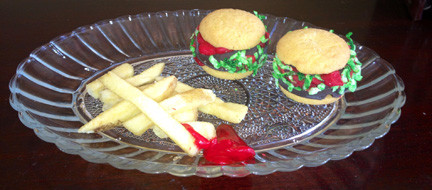Is it or isn’t it (a dessert)? Only the chef knows for sure!
Last week I shared a burger recipe, this week I have another. Last week it was a main, this week it’s a dessert.
Sweets date back to ancient civilizations. Desserts, as we know them today, are the product an evolution of technology and culinary experimentation.
The word dessert originated from the French word desservir, “to clean the table,” and the negative of the Latin word servire.
In ancient times, civilizations enjoyed the treats of fruit or nuts rolled into honey, which has become known as the first candy — it was what was available to them at the time. The ingredients that were available in each region influenced the desserts that they were able to create. Desserts back then were simpler to prepare, as ancient cultures focused more on nutrition in the food ingested, in order to survive. I’m guessing that’s why there were no sports club chains or personal trainers around then — that and the fact that they burned more calories hunting their food than we do driving to the supermarket. (OK, I do admit on Friday we burn off a few hundred additional calories driving around for hours looking for parking spots!)
So in theory, people in ancient times enjoyed an occasional sweet treat, but it wasn’t until sugar was manufactured during the Middle Ages that people began to enjoy more sweets. Even then, sugar was so expensive, that it was a treat reserved only for the wealthy on special occasions.
Seems it was during the beginning of the 17th century that desserts took their place. Before this time, sugary and salty dishes were often mixed and it is difficult today to discern which dishes were main courses and which dishes were officially dessert.
When it comes to Renaissance desserts, it looks like Catherine de Medicis’ Italian chefs were the ones who really created and introduced desserts, first in Italy and then making their way up to France. The most common desserts were tarts, pies, flans, custards, rice puddings, rissoles, jellies, and sabayons, almost all known for their very high sugar content! In fact, not only were Renaissance desserts known for their large quantities of sugar, but also for the unusual mix of sugar with vinegar, alleged to be a health tonic.
Today, although some people are still into natural candies and nuts, most have moved onto complex soufflés, multi layered cakes, tiramisu, baked Alaska and intricate fondant cakes that can basically replicate just about everything from baby grand pianos, cars, a burning building with fire engines and smoke and water, to designer shoes and pocketbooks. Should anyone want to surprise someone with a birthday cake, for the same money as those designer bags cost in fondant, just stick the real thing on a platter and sing Happy Birthday … just saying …
Some interesting dates and firsts for you sugar-philes out there:
n 1381: First printed recipe for Tartys in Applis, or apple pie
n 1400: Gingerbread was made by soaking bread crumbs in honey and spices
n 1600: Pralines were created by a table officer of French nobility
n 1700: Eclairs--with a cream center and chocolate topping evolved slowly over several hundred years
n 1740: Cupcake recipes were commonly recorded by this time
n 1800s: Lemon meringue pie wasn’t invented until the 19th century but meringue and lemon custards were common before then.
One dessert I’m sure they didn’t have back in ancient times or even during the Renaissance is mini hamburgers made into a dessert out of cookies. An easy and fun ending after a barbecue that will delight adults, as well as the kids.
•••
Shout out to my friends who were over for a barbecue this past Sunday who thought they were real burger sliders and took cell phone pix to send to their kids… .Let me know if any of them end up on Instagram.
Mini Burgers, Dessert Style
Ingredients: Bloom’s Vanilla Wafers (for the buns); Lieber’s Chookies for the burgers (Chookies are pareve sandwich cookies coated in chocolate); 1 cup shredded coconut (for the lettuce); 3 drops Green Food Coloring, with 3 drops of water or a smidgeon “leaf green” Wilton’s icing color (to color the coconut); 1 tube (4.25 oz )Betty Crocker decorating icing in red (for the ketchup).
Directions:
n Toss the coconut and food coloring in a plastic bag till all coconut is green.
n Place 20 wafers on a sheet tray top side down and place a small dab of red icing in the center.
n Place one Chookie on top of each wafer and gently press down so the “burger” will stick to the “bun.”
n Pipe a thick ring of red icing along the perimeter of the Choookie; be generous.
n Sprinkle some coconut onto the red icing and press down another vanilla wafer on top. “Ketchup” should ooze out and look like it’s dripping down.
n Experiment with the first few to get the result you like.
For the photo, I added French fry chips. You can also pair the burgers with small thin biscotti or cookies shaped to look like French fries and add red icing for the ketchup.
Judy Joszef is a pastry and personal chef as well as a party planner. She can be reached at judy.soiree@gmail.com

 66.0°,
Shallow Fog
66.0°,
Shallow Fog 







